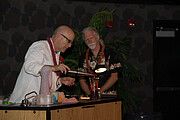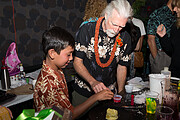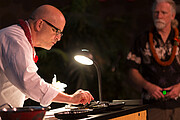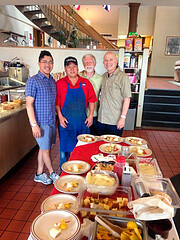gAstronomy & Exoplanets: Food for Thought!
2 October 2014
On Saturday evening, July 19th, Gemini Observatory, in a partnership with the ‘Imiloa Astronomy Center shared with Hawai'i residents "The Adventures of gAstronomy!" Dr. Steve Howell, Project Scientist for NASA's Kepler Planet Finding Mission, and Chef Bill Yosses, former White House Executive Pastry Chef, wowed the audience with their speculation about the conditions on selected exoplanets -- which inspire recipes for chefs like Yosses.
Numerous samples of exoplanet-inspired culinary delights, from mango spheres, to exotic foams, and polymers, titillated audience's taste buds throughout the evening. “The excitement of discovering thousands of exoplanets can be brought right into your kitchen,” said Howell, who added that, “The same science principles astronomers use to understand alien worlds are used to create marvels of culinary delight.” Together, Howell and Yosses have combined modern molecular gastronomy methods, and basic physics, to teach a little of both, and provide exotic taste treats.
“We believe the enthusiasm we have for cooking and science is contagious and this event at the ‘Imiloa Planetarium proves that new discoveries in one field can generate waves of new ideas in others. We want to thank the Gemini and ‘Imiloa teams, the volunteers, and the Hilo community for their support,” Chef Yosses noted.
We hope these photos capture some of the event’s “flavor!”
Dr. Howell and his research/observing team are in Hilo/Hawai'i Island to observe with the Gemini North telescope on Mauna Kea. Using their visiting instrument -- DSSI (Differential Speckle Survey Instrument) – they will confirm and explore dozens of Kepler discovered exoplanet candidates.
UPDATE: Here are two "recipes" you can use to re-create either Oxygen Foam or Slime as seen during the event.
Procedure for making a long-lasting Oxygen Foam
The basic science here is that you have hydrogen peroxide, which could be called hydrogen dioxide, since it is just a water molecule with an extra oxygen atom attached. Hydrogen peroxide is H2O2, water is of course H2O. By adding another chemical, called a catalyst, to the peroxide, you start a chemical reaction that releases the extra oxygen attached to the water molecule. If you mix in a little dish soap you can capture the released oxygen gas in the form of bubbles.
You will need…
- an empty 16 oz. plastic soda or water bottle or simply a plastic glass
- 1/2 cup 3% hydrogen peroxide (the kind you buy in a drug store). Hydrogen peroxide is simply water with an extra O atom attached. H2O + O = H2O2. This extra O atom is what we will be releasing during the reaction.
- Dish detergent, such as Dawn liquid – this will capture the O2 into bubbles
- Food coloring – for fun
- 1 teaspoon (or half a packet) of yeast dissolved in warm water
What to do:
Fill your soda bottle (or glass) with the 1/2 cup of peroxide. Add a squirt or two of dish detergent. Add a squirt or two of your favorite food coloring (or a combination) to make things a bit festive. Note: The food coloring is only for fun and is not needed.
Now you need to prepare your yeast. The yeast acts as a catalyst to release an oxygen atom from the hydrogen peroxide. These free O atoms will combine to form O2 resulting in the reaction H2O2 à H2O + O2. Add the teaspoon of yeast to a few tablespoons of warm water, stir and let sit for 30 seconds. This yeast solution will give you a rich creamy foam of tiny bubbles.
Add the yeast solution to the hydrogen peroxide solution. You will get quite a surge of tiny soapy bubbles. The long lasting foam will be warm because this reaction is exothermic, that is it produces heat.
Procedure for making Slime, a cross-linked polymer
You will need…
- 1 cup hot water
- 1.5 tsp. Borax (non-toxic/available by laundry detergents, sodium borate)
- 2 cups clear school glue – note this has to be polyvinyl alcohol (PVA). Do not be confused with the PVA polyvinyl acetate, it will not work in the experiment.
- 2 cups warm water
- 1 tsp. some coloring, food colors work fine. For a “glow in the dark” slime, use yellow high-lite marker dye (Fluorescent). See below.
What to do:
- Mix 1 cup hot water and 1.5 tsp. of Borax until dissolved. Set aside.
- Mix 2 cups of clear polyvinyl alcohol glue and 2 cups of warm water together in a plastic bowl.
- Add food coloring or “glow in the dark” coloring.
- Using a metal spoon (much more fun to use your fingers), slowly pour Borax mixture into the glue mixture while stirring quickly. Stir and the mixture will begin to thicken, become sticky and slimy. For a thicker slime, add more Borax solution. Play with the slime.
**Making “glow in the dark” slime dye. Take a yellow high-lite marker and break it open. Inside is a yellow colored cartridge soaked with Fluorescent, a compound that absorbs very blue and ultraviolet light and re-emits it as yellow-green light. Place the cartridge in a glass of water and let it sit for a few hours. The water will turn yellow as the water-soluble dye is absorbed into the water. Use the water as you would food coloring to color the slime.
Links
Here you can find the full videos to give you just a taste of what happened:







